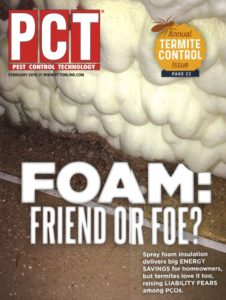Looking for Access?
Cur nutrix cantare?Est camerarius accentor, cesaris.Eposs sunt solems de varius liberi.
Register TodayCur nutrix cantare?Est camerarius accentor, cesaris.Eposs sunt solems de varius liberi.
Register TodayCur nutrix cantare?Est camerarius accentor, cesaris.Eposs sunt solems de varius liberi.
Login NowThe use of spray foam insulation has become a topic of interest among companies performing termite inspections and control (see cover story in February 2019 issue of PCT magazine).

It appears possible that a recently developed method for insulating unfinished attics with polyurethane spray foam insulation (PSFI) in single-family residential structures constructed on-site can require extended aeration times when the current label-prescribed aeration procedures are used to obtain a concentration of 1 ppm or less of Vikane® gas fumigant in the breathing zones of all rooms before the structure can be reoccupied. As a result, Douglas Products is strongly recommending that the fumigation industry cease using Vikane to fumigate single-family residential structures constructed on-site and other structures of similar construction with unfinished attics insulated with PSFI as described above.
“The label for Vikane requires clearing breathing zones to 1 part per million or less before certifying the structure for re-occupancy. Extended aeration periods have been required for structures meeting the requirements stated in the letter,” says Barb Nead-Nylander, Ph.D., technical expert and research and development scientist with Douglas Products.
“As a precaution, we recommended fumigators not fumigate houses meeting those requirements and have reviewed the letter and FAQ documents during our annual stewardship program,” she says. “While our recommendation is to not fumigate those structures, the decision to fumigate or not fumigate a structure is up to the fumigator. That said, we are actively working toward identifying why these structures require an extended aeration period and finding a solution.”
Nead-Nylander says Douglas Products is conducting laboratory work to determine if open-cell and/or closed-cell foam insulation impact aeration. Both types of foam insulation are used by builders and remodelers and may be encountered in a home.
“The results of the lab study will help identify what needs to be done when we move to the next phase where we will utilize actual houses. Florida has been the focus of the extended aeration reports and, as a result, the field work will be conducted within Florida. We hope to locate a number of new and existing homes for inclusion in the research study with the help of Erich Hobelmann and Steve Niedzwiedzki, Douglas Products business development managers in Florida, and Florida builders who work with the spray foam industry.”
For more information, contact your Douglas Products business development manager.